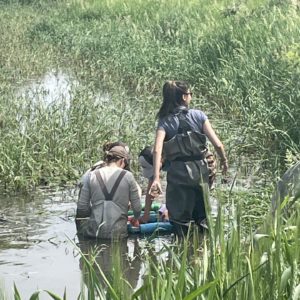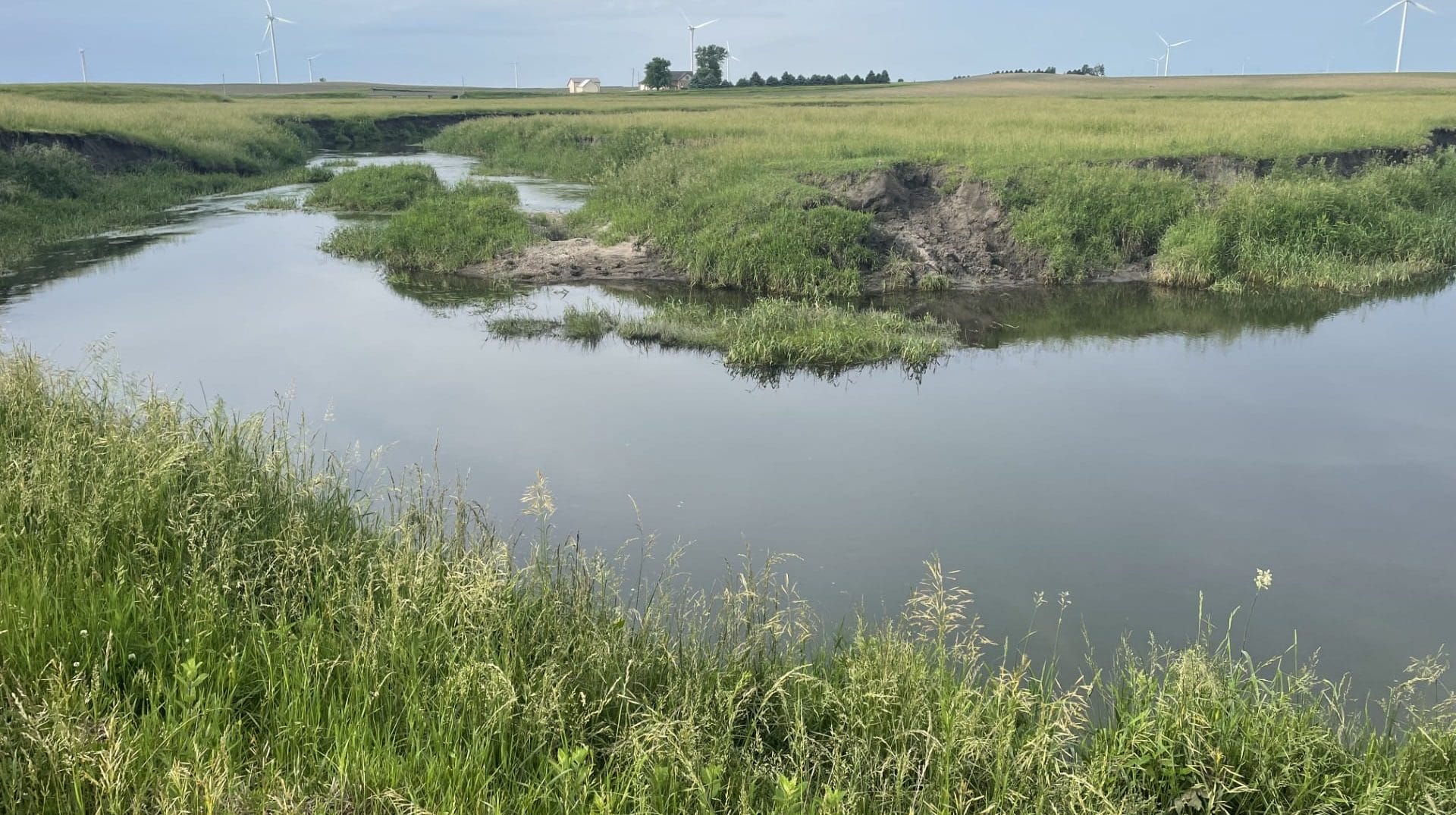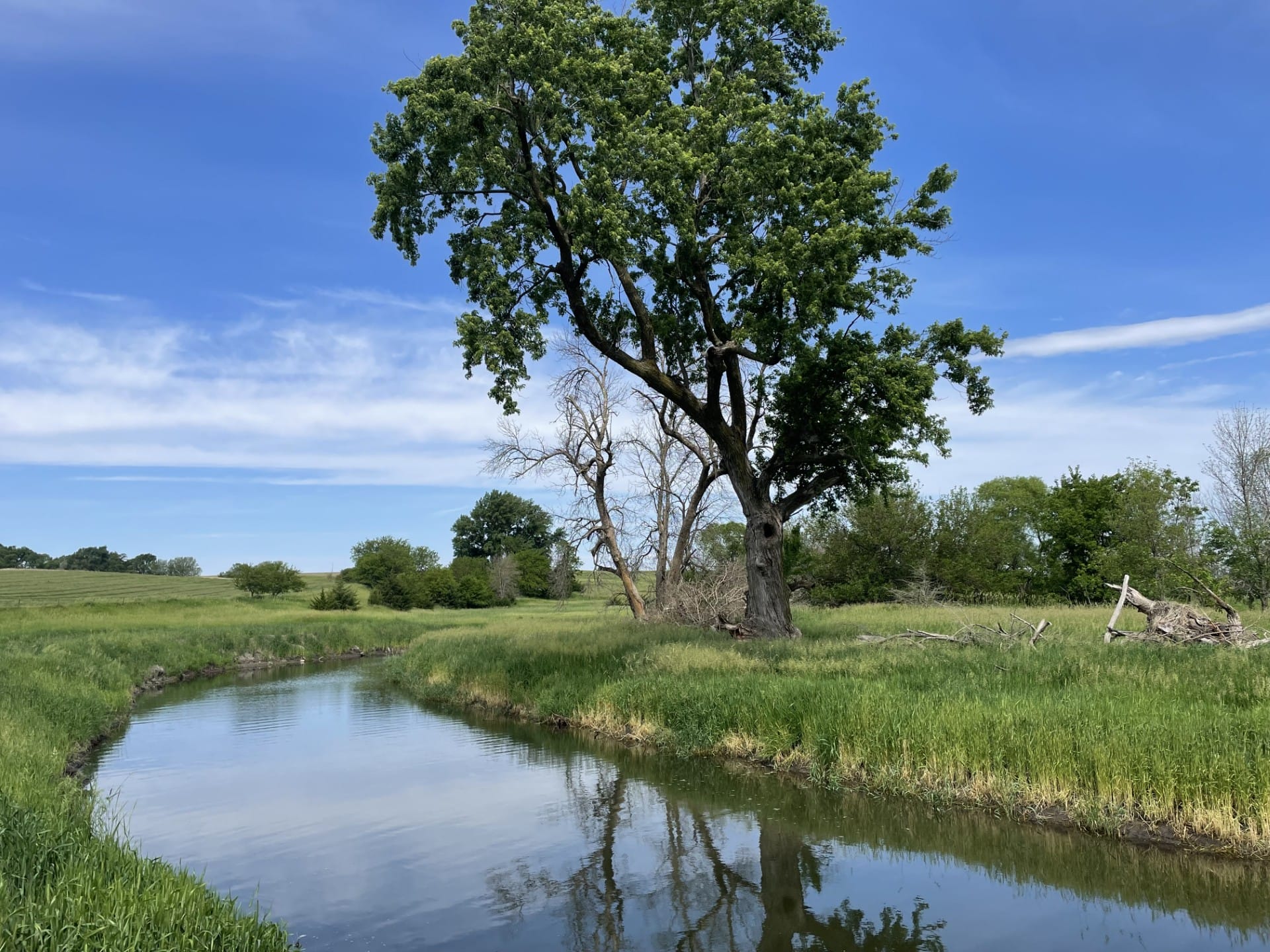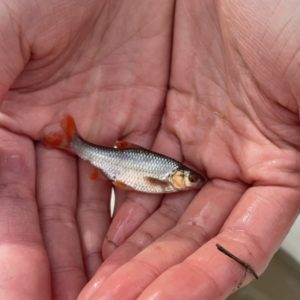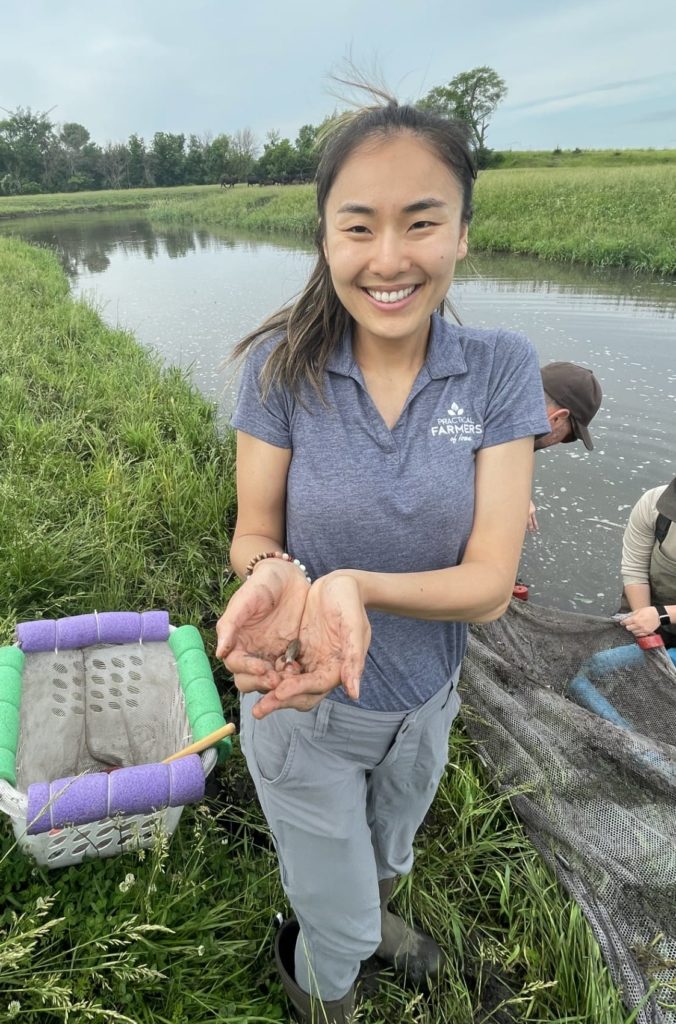Topeka Shiners Thriving in Restored Oxbow Habitats
Habitat staff at Practical Farmers of Iowa, along with Darrick Weissenfluh from the U.S. Fish & Wildlife Service, participated in sampling restored oxbows in early June in search of the Topeka shiner, an endangered fish species that lives in Iowa and a few other states in the Midwest.
Oxbows are former stream meanders that are typically U-shaped and have become separated from the current stream. They are often referred to as oxbow lakes and are integral parts of healthy river systems that serve as vital habitat for many species. As human activity has altered river dynamics, however, many oxbows have been lost, imperiling species like the Topeka shiner.
PFI and the USFWS have worked together over the last two years to restore oxbows in central Iowa. Over that time, PFI and USFWS, with assistance from Iowa Soybean Association, have located in the North Raccoon River Watershed, using funding provided by the Iowa Department of Agriculture and Land Stewardship.
Multi-purpose oxbow restorations are tile-fed, meaning they receive field drainage water from tile. In Iowa, water quality remains an important issue, with nonpoint source pollution being the top concern. Restoring oxbows has a positive impact on both land and water.
Multi-purpose oxbows filter out excess nutrients, such as nitrates, from agricultural runoff and tile drainage. Studies show oxbows that intercept agricultural tile drainage can filter 42%-100% of excess nutrients. For that reason, multi-purpose oxbow restoration is a practice included in the Iowa Nutrient Reduction Strategy.
Oxbow restoration involves removal of sediment and organic material that accumulates in the oxbow depressions over time, restoring wetland habitat and oxbow function. Additionally, the sediment and organic material excavated from oxbows is often spread on adjacent crop fields, replenishing nutrients in the soil.
Restoring additional habitat, such as prairie strips, adjacent to the oxbow filters potential pollutants that may move across the landscape and into our waterways. Improving the quality of both oxbows and the surrounding landscape restores habitat that the Topeka shiner, and many other fish and wildlife, need to survive and flourish.
Sampling for Shiners
PFI staff members, Grace Yi and Vanya North, accompanied USFWS staff on one of their sampling days to four restored oxbows in Greene and Calhoun counties. A seine net was pulled through each restored oxbow to capture fish to determine if Topeka shiners were present and to get an idea of the species diversity in each oxbow.
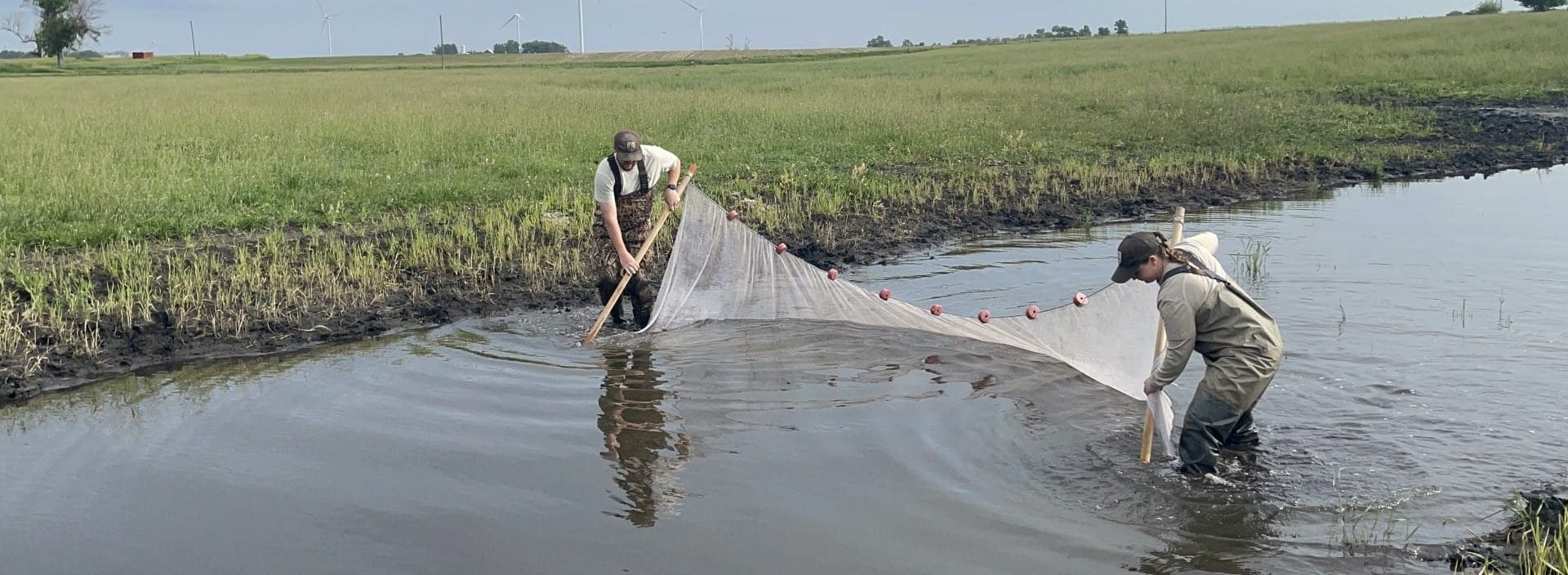
Seine netting is used to safely scoop fish from the water. This practice captures the most fish possible, giving conservationists a better idea of species diversity in an area.
Topeka shiners prefer oxbows due to their pond-like nature instead of main river channels as those areas are especially prone to variable – and sometimes poor – water quality conditions.
On the day of sampling, PFI staff got their hands dirty wading alongside USFWS staff and interns to pull in the large net, collecting and cataloguing specimens. Topeka shiners were found at all four sites, along with species like the fathead minnow, orange spotted sunfish, and the spotfin shiner.
During the week of sampling, the USFWS sampled restored oxbows adjacent to Camp Creek, Hardin Creek, Purgatory Creek, Cedar Creek, Lake Creek and the North Raccoon River.
Topeka shiners were found in each oxbow that was confirmed to have connected with their adjacent creek or river prior to sampling, indicating a successful restoration of their habitat.
In total, during the weeklong sampling, 6,207 fish were captured, recorded and freed, representing 22 different species.
| Fish Species Recorded During Oxbow Sampling in June 2024 |
| Bigmouth Shiner | Brassy Minnow |
| Bluntnose Minnow | Red Shiner |
| Black Bullhead | Central Stoneroller |
| Fathead Minnow | Johnny Darter |
| Orange Spotted Sunfish | Gizzard Shad |
| White Sucker | Common Carp |
| Sand Shiner | Brook Stickleback |
| Topeka Shiner | Spotfin Shiner |
| Creek Chub | River Carpsucker |
| Common Shiner | Bluegill |
| Green Sunfish | Black Crappie |
Insights From Grace Yi: Sampling Experience With USFWS
Grace Yi is the senior habitat viability coordinator at Practical Farmers of Iowa. Grace equips farmers and landowners with technical assistance and financial resources needed to establish and maintain wildlife habitat. I sat down with her to get her perspective on oxbow sampling.
Why is this project important to you?
This project was important to me because it filled the much-needed gap both environmentally and programmatically. Restoration projects that involve excavation or “dirt work” often come with very steep price tags, so it’s difficult for landowners to take these types of projects on.
There have been cost-share programs for oxbow (and other wetland) restoration projects, but I don’t believe there have been ones that provided 100% cost-share like our program did without having to enter into an easement contract. I’m very proud of our USFWS and PFI partnership that streamlined the oxbow restoration processes to make it as easy and quick as possible to put oxbows on the landscape.
Finally, I found oxbow restoration projects meaningful because they are so versatile and provide a host of benefits. Restored oxbows can provide habitat for both aquatic and terrestrial species, improve water quality by filtering excess nutrients and sediment, protect stream banks by slowing down stream flow during and after rain events by storing flood water, and they beautify our landscape.
What was your favorite part of the day?
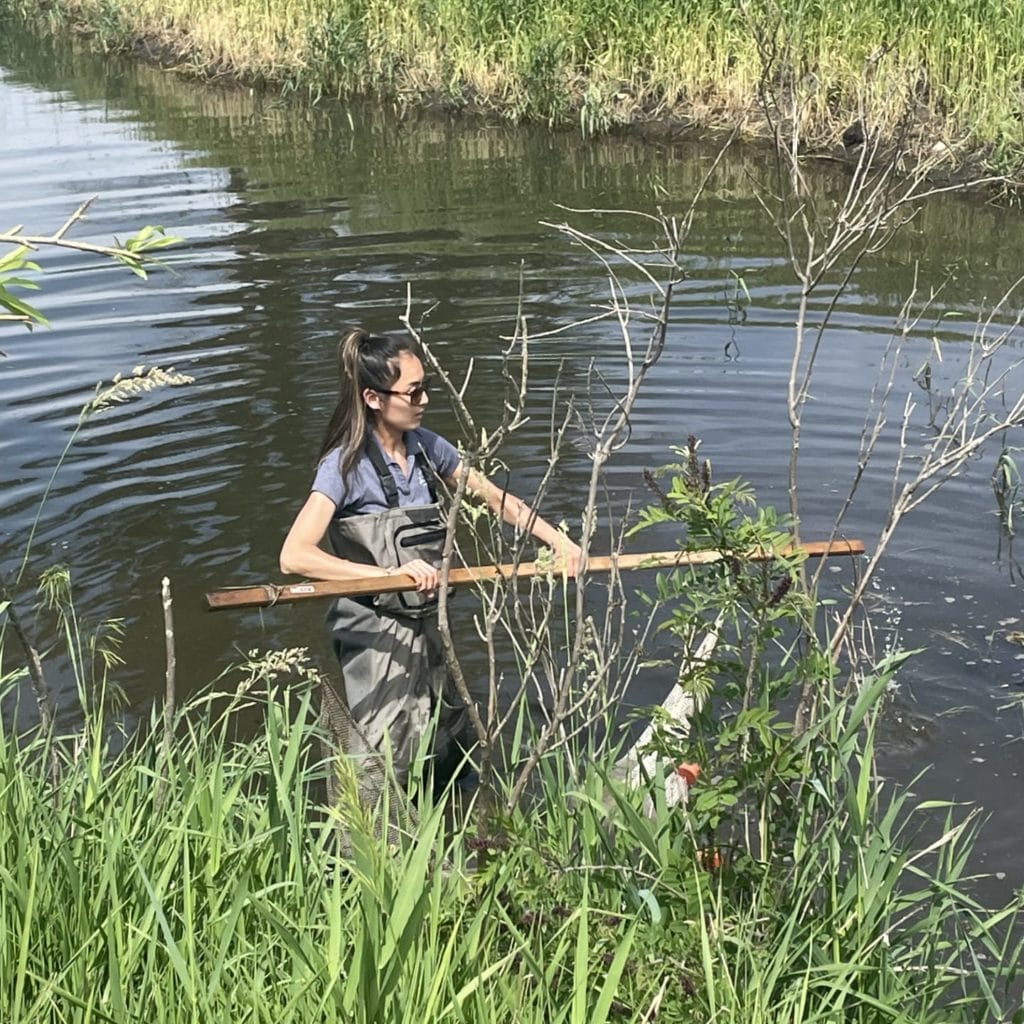
Grace Yi, senior habitat viability coordinator, wades into a restored oxbow, searching for Topeka shiners.
All of it! Most conservation practitioners would say the reason they entered this line of work is because they enjoy being outdoors, and it was a beautiful day to be out of the office. And I’m sure any reader can relate to that rewarding feeling of witnessing successful outcomes – in this case finding a whole lot of Topeka shiner – after all the work that goes into a project.
I love continuing to grow as a conservation practitioner, and this was a fantastic, hands-on experience to learn about different fish species and what goes into sampling wetlands from our USFWS partner staff. Speaking of which, I thoroughly enjoy and appreciate our partnership with USFWS, so it’s always good to connect with them in-person.
Anything else you may want to add?
I think of oxbows as like panda bears of wetlands. The name “oxbow” is catchy and easy to remember. While probably not as many people are familiar with oxbows as they are of pandas, once they learn about oxbows, there seems to be an instant connection and interest in them. Anything that brings people closer to their land and stewardship is special!
Additionally, areas with oxbows are often already not cropped because they’re not very farmable due to the depression or soil composition or flooding. Without having to consider the opportunity cost of growing crops on those acres anyway, it seems to be an easier decision for landowners to restore these oxbows if they can find good cost-share programs.
To learn more about what you can do to improve water quality and habitat on your farm or acreage, visit our website to learn more about PFI’s Habitat Incentives Program.

